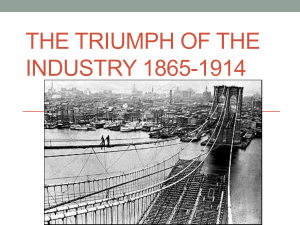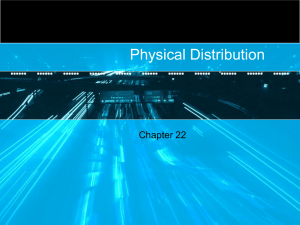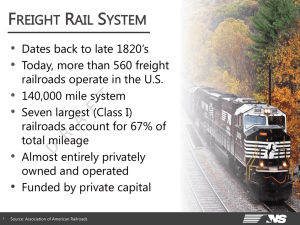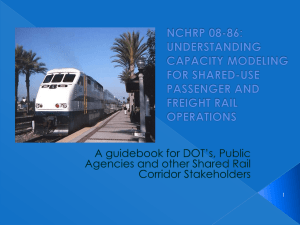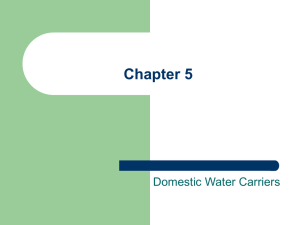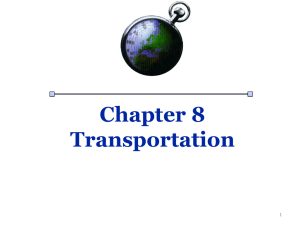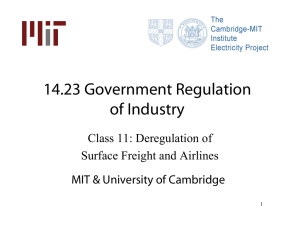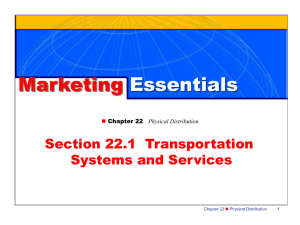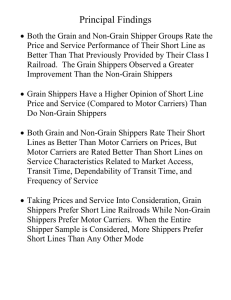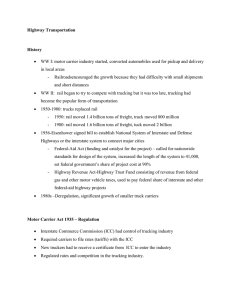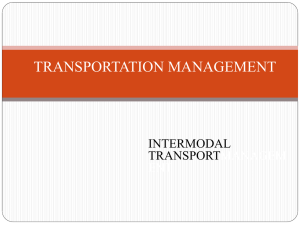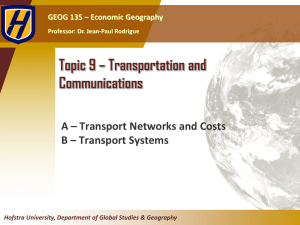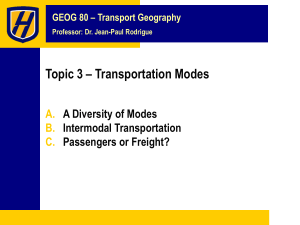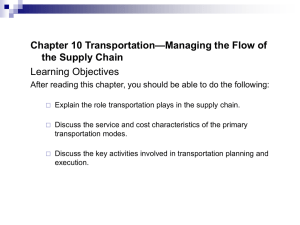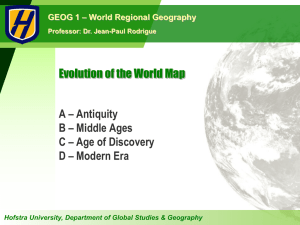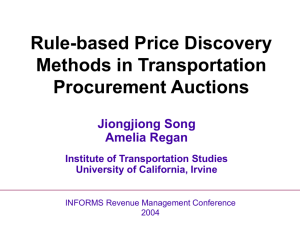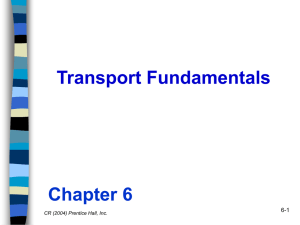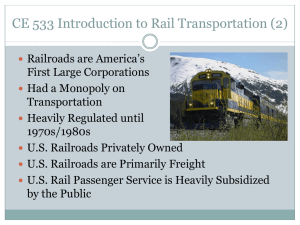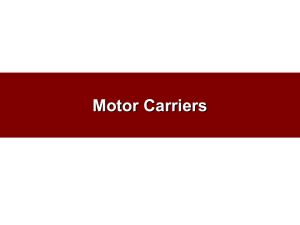Freight Transportation Regulation
advertisement
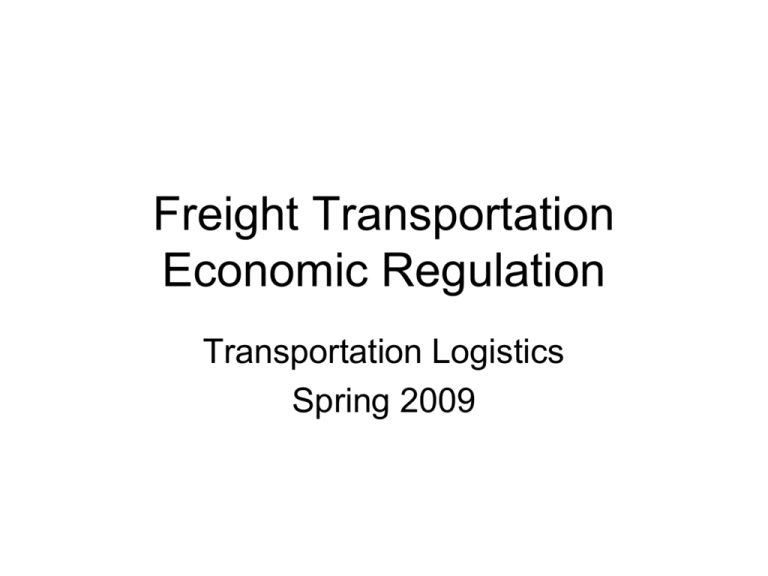
Freight Transportation Economic Regulation Transportation Logistics Spring 2009 Transportation Participants I need something shipped at the lowest possible cost! Transportation Participants I need something shipped at the lowest possible cost! I need something delivered at the lowest possible cost! Transportation Participants Carriers: We have the equipment! Transportation Participants Carriers – we can find a shipper! Shippers – we can find a carrier! Transportation Participants the transportation system is vital for the country’s economic health Transportation Participants purchase fuel, transportation equipment, supplies Transportation Participants track shipments purchase fuel, transportation equipment, supplies Transportation Participants track shipments purchase fuel, transportation equipment, supplies match products needing to be shipped with available capacity Transportation Participants Creates demand for transportation by purchasing products Types of Transportation Regulation Economic • Investments in transportation infrastructure (e.g., highways, airports, ports) • Control of routes, pricing, schedules Types of Transportation Regulation Economic • Investments in transportation infrastructure (e.g., highways, airports, ports) • Control of routes, pricing, schedules Social/Safety • Protect the public, the environment • Make sure equipment operates safely, cleanly • Safe transportation of hazardous materials (HAZMAT) • Regulating hours worked Robber Barons Initial Regulation • Railroads provided a needed and valuable service to millions of customers in an unregulated market economy • Interstate Commerce Commission formed in 1887 – Regulate railroads – Fix price ceilings – Prevent them from making a profit that would be deemed excessive • 1916 was year of peak trackage (254,000 miles) History of Transportation Regulation • 1920-1940 – Regulatory formalization, extension to other transportation modes – Motor Carrier Act (1935) – Civil Aeronautics Act (1938) – Civil Aeronautics Board (1940) History of Transportation Regulation • 1940-1970 – Regulation of water transportation by ICC (1940) – National Aeronautics & Space Administration (1951) – Federal Aviation Administration (1958) – Railroad Revitalization and Regulatory Reform Act of 1976 • AMTRAK • CONRAIL History of Transportation Regulation • 1970-1980 – prelude to deregulation – Shift from regulation/control to fostering competition – Department of Transportation (DOT) 1961 – Airline Deregulation Act 1978 History of Transportation Regulation • 1980-2000 – Deregulation – Motor Carrier Act 1980 – Staggers (Rail) Act 1980 – Interstate Commerce Commission (ICC) abolished in 1996 – Ocean Shipping & Reform Act 1998 Freight Transportation and the Economy Efficient Transportation Infrastructure Investment Increased Transportation Capacity, Efficient, Reliability, and Level of Service Transportation Cost Savings Transit Time Savings (Reliability Improvement) Increased Productivity Increased Competitiveness Increased Economic Growth Business Expansion (Relocation and Restructuring) Effects of Improved Freight Transportation Firstorder Benefits Immediate cost reductions to carriers and shippers, including gains to shippers from reduced transit times and increased reliability. Secondorder Benefits Reorganization-effect gains from improvements in logistics. Quantity of firms’ outputs changes; quality of output does not change. Thirdorder Benefits Gains from additional reorganization effects such as improved products, new products, or some other change. Other Effects Effects that are not considered as benefits according to the strict rules of benefit-cost analysis, but may still be of considerable interest to policy-makers. These could include, among other things, increases in regional employment or increases in rate of growth of regional income. Revenue down Employee productivity up Trucking has become more competitive, with thin margins Longer combinations are growing faster (more cost effective) Truck miles have grown faster than the economy Freight represents a greater percent of total traffic Total Logistics Costs Down Substitute transportation spending for inventory spending Rail Track Mileage and Number of Class I Rail Carriers, United States, 1830-2005 300,000 Rail Track Mileage Class I Rail Carriers 180 160 140 Miles of tracks 200,000 120 150,000 100 80 100,000 Rail Carriers 250,000 200 60 40 50,000 20 0 1830 0 1850 1870 1890 1910 1930 1950 1970 1990 Copyright © 1998-2007, Dr. Jean-Paul Rodrigue, Dept. of Economics & Geography, Hofstra University. For personal or classroom use ONLY. This material (including graphics) is not public domain and cannot be published, in whole or in part, in ANY form (printed or electronic) and on any media without consent. This includes conference presentations. Permission MUST be requested prior to Average Speed of Class I Railroads, 1945-2004 40 Kilometers per hour 35 30 25 20 15 1945 1955 1965 1975 1985 1995 2005 Copyright © 1998-2007, Dr. Jean-Paul Rodrigue, Dept. of Economics & Geography, Hofstra University. For personal or classroom use ONLY. This material (including graphics) is not public domain and cannot be published, in whole or in part, in ANY form (printed or electronic) and on any media without consent. This includes conference presentations. Permission MUST be requested prior to Performance of Class I Railroads, 1964-2005 300 Productivity Volume Revenue Price Index 1981 = 100 250 200 150 100 50 0 1964 1968 1972 1976 1980 1984 1988 1992 1996 2000 2004 Copyright © 1998-2007, Dr. Jean-Paul Rodrigue, Dept. of Economics & Geography, Hofstra University. For personal or classroom use ONLY. This material (including graphics) is not public domain and cannot be published, in whole or in part, in ANY form (printed or electronic) and on any media without consent. This includes conference presentations. Permission MUST be requested prior to Consequences • Has deregulation – – – – reduced barriers to entry? improved intermodal transport and productivity? improved effect of market pressures? improved customer’s choices?
